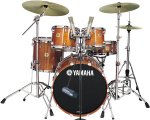Halion
New member
Today I got the chance to record a great drummer. I had 5 hours time to record a single song (pop rock), so I had lots of chance to mess with micing techniques. Let me post a small summary of what I tried:
Last timed I miked drums I had a U87 still standing in the room and I thought, hey lets just stick this in front of the kit and see what becomes of it. It turned to have a near perfect balance of everything in it. The cymbals were a little loud and the snare didn't have the attack it can have when close micing but it did have a cohesive, glued together sound of all the drums. So today I decided to try the same, but instead of adding some overheads, place 2 mics directly left and right of the kit, at tom level. + kick mic. It didn't work too well. The cymbals where extremely left or right, and they washed over most the toms + snare. I didn't like the tone of the toms like this either (although the drumkit was great, we tuned to toms aswell). Next, I tried an AB pair (about a foot from each other, a little too little I think) behind the drummer, coupled with an SDC on the snare (pointed at the side of the snare), and and RE20 on the kick (in front of the hole, about 10 cm outside of the kick). This turned out to give a very ambient kick sound (I put the RE20 inside the kickdrum before this). The snare sounded pretty good, although a top/bottom dynamic mic pair would probably have worked a little better. The cymbals and toms were much better balanced, because where miked from the back. I added an SM underneath the toms, pointing horizontally at the lowest rack tom and the floor tom. This gave a HUGE buttom end to those toms, I didn't think it would be possible to get this kind of sustain and boom out of these.
All in all, I think the kick turned out not punchy enough, and the snare didn't have the snap it would have when miced top and bottom. The hihat wasn't as focussed as when close miked aswell. On the other hand, it did sound like a miked kit more than anything, no library will be able to fake it like this.
Conclusion: I still feel that only close miking + overheads provides too direct a sound, but this was an other extreme. I think with another experimenting sesion or 2, I will have a very good own miking technique, so I'm happy
Last timed I miked drums I had a U87 still standing in the room and I thought, hey lets just stick this in front of the kit and see what becomes of it. It turned to have a near perfect balance of everything in it. The cymbals were a little loud and the snare didn't have the attack it can have when close micing but it did have a cohesive, glued together sound of all the drums. So today I decided to try the same, but instead of adding some overheads, place 2 mics directly left and right of the kit, at tom level. + kick mic. It didn't work too well. The cymbals where extremely left or right, and they washed over most the toms + snare. I didn't like the tone of the toms like this either (although the drumkit was great, we tuned to toms aswell). Next, I tried an AB pair (about a foot from each other, a little too little I think) behind the drummer, coupled with an SDC on the snare (pointed at the side of the snare), and and RE20 on the kick (in front of the hole, about 10 cm outside of the kick). This turned out to give a very ambient kick sound (I put the RE20 inside the kickdrum before this). The snare sounded pretty good, although a top/bottom dynamic mic pair would probably have worked a little better. The cymbals and toms were much better balanced, because where miked from the back. I added an SM underneath the toms, pointing horizontally at the lowest rack tom and the floor tom. This gave a HUGE buttom end to those toms, I didn't think it would be possible to get this kind of sustain and boom out of these.
All in all, I think the kick turned out not punchy enough, and the snare didn't have the snap it would have when miced top and bottom. The hihat wasn't as focussed as when close miked aswell. On the other hand, it did sound like a miked kit more than anything, no library will be able to fake it like this.
Conclusion: I still feel that only close miking + overheads provides too direct a sound, but this was an other extreme. I think with another experimenting sesion or 2, I will have a very good own miking technique, so I'm happy



